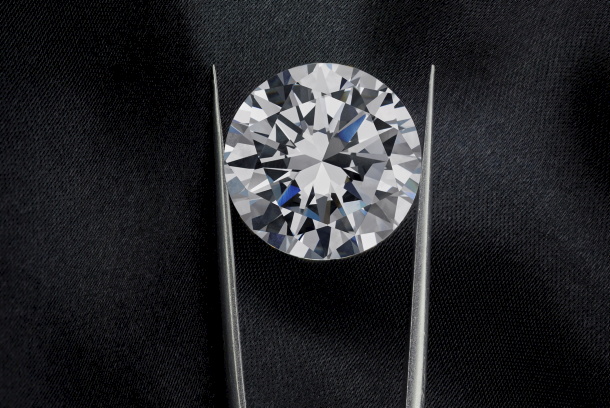A loose diamond refers to a diamond that is not yet set in any type of jewellery. It is an unmounted stone that remains free, allowing for a more detailed assessment of its qualities before it is placed into a setting such as a ring, necklace, or bracelet. This freedom provides several benefits, including a clearer understanding of the diamond’s characteristics and the flexibility for buyers to choose their preferred mounting.
Importance of Loose Diamonds in the Jewellery Industry
Accurate Evaluation:
When a diamond is loose, its attributes—such as its cut, colour, clarity, and carat weight (the Four Cs)—can be accurately assessed. The diamond is viewed from all angles, and precise measurements can be made. This allows for a thorough and precise evaluation, which is impossible when the diamond is set in jewellery, as the setting may obscure parts of the stone.
Grading labs, such as the Gemological Institute of America (GIA) or the Diamond Certification Laboratory of Australia (DCLA), require diamonds to be loose for accurate certification. When a diamond is mounted, it may be challenging to fully assess certain characteristics, especially clarity, as inclusions might be hidden by the setting.
Better Market Transparency:
Loose diamonds provide greater transparency in the marketplace. Buyers can inspect and compare the characteristics of different diamonds in their natural state. This also allows for greater flexibility in selecting the right stone for a specific piece of jewellery, as customers have the option to customise the setting later based on the loose diamond’s shape and size.
Advantages of Purchasing a Loose Diamond
Customisation:
Purchasing a loose diamond allows the buyer to have full control over the design of their jewellery. Whether it’s for an engagement ring, a pendant, or earrings, customers can choose the setting that best complements their diamond, resulting in a more personalised and unique piece of jewellery.
Loose diamonds also provide the opportunity to create bespoke designs, as they are not restricted to pre-existing settings. Buyers can work with a jeweller to design something that reflects their personal style and preferences.
Cost Efficiency:
A loose diamond may be more affordable than a pre-set diamond in a piece of jewellery, as you are only paying for the stone itself without the cost of the setting. Additionally, buying loose allows buyers to explore different pricing options, including different grading and certification levels, without paying for an expensive mount.
The cost of setting a loose diamond is a separate consideration, but in many cases, the buyer may save on the mounting compared to purchasing an already mounted diamond.
Greater Selection:
Buying a loose diamond offers a wider selection of stones. You are not limited to the diamonds that are already set in jewellery, which may not fit your preferences in terms of quality, shape, or size. Loose diamonds give access to a broader variety of shapes (round, princess, oval, emerald, etc.), sizes, and grades, allowing you to choose a diamond that best suits your needs.
Investment Potential:
Loose diamonds are also popular with investors. They are portable, can be easily stored, and often maintain or increase their value over time, especially high-quality diamonds with favourable characteristics. As the diamond market continues to evolve, loose diamonds provide the flexibility to resell or trade them more easily compared to mounted diamonds.
Challenges of Loose Diamonds
Vulnerability to Damage:
While being unmounted offers several benefits, it also leaves the diamond more exposed to damage. Without a setting to protect it, a loose diamond can be scratched, chipped, or lost more easily. Buyers should take extra care when handling and storing loose diamonds to avoid accidental damage.
Secure packaging and proper storage are critical to maintain the diamond’s condition.
Setting Delays:
After purchasing a loose diamond, the buyer may face delays in having the stone set into their chosen jewellery. The setting process can take time, especially if custom work is involved, and the jewellery itself may not be ready for immediate wear.
It is important to account for the time it takes to create the jewellery around the diamond, which may affect when the customer can actually wear or present the piece.
Loose Diamond Certification
Loose diamonds are typically certified by independent gemological laboratories. This certification ensures that the diamond has been graded and evaluated according to universally recognised standards. The Four Cs (cut, colour, clarity, and carat weight) are the main criteria used to assess the quality of a diamond.
Cut: The diamond’s proportions, symmetry, and polish. This affects how well the diamond reflects light, influencing its brilliance and overall appearance.
Colour: The lack of colour in the diamond. Diamonds are graded on a scale from D (colourless) to Z (light yellow or brown).
Clarity: The presence of internal or external flaws, called inclusions and blemishes. The fewer the imperfections, the higher the clarity grade.
Carat Weight: The weight of the diamond, with one carat equalling 200 milligrams. Larger diamonds are rarer and typically more valuable.
Certification provides reassurance to buyers that the diamond meets certain standards and helps them understand its true value. The report usually includes a diagram of the diamond’s inclusions and any other notable features, which are critical for understanding its characteristics.
Where to Buy Loose Diamonds
Loose diamonds can be purchased from a variety of sources:
Jewellers and Diamond Retailers: Many well-established jewellers offer loose diamonds for sale. Some may also have diamond grading reports available for each stone, giving buyers more confidence in their purchase.
Online Platforms: Online marketplaces and diamond retailers provide access to a large selection of loose diamonds, often with detailed information about each stone’s grading and certification. Some platforms even allow buyers to filter diamonds based on specific criteria, such as carat weight, cut quality, and colour.
Diamond Auctions: For collectors and investors, diamonds can also be found at diamond auctions, where high-quality loose diamonds are sold to the highest bidder.
